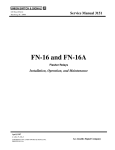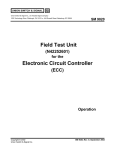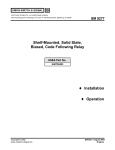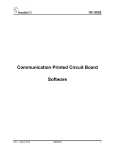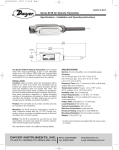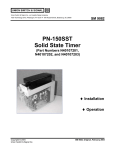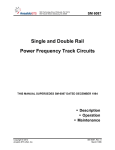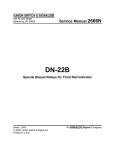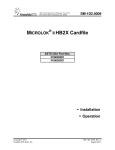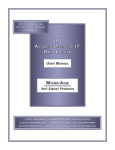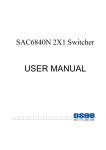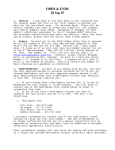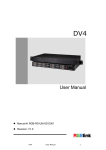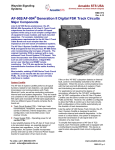Download LED Signal - Ansaldo STS | Product Support
Transcript
SM-7A1.0001 1000 Technology Drive, Pittsburgh, PA 15219 645 Russell Street, Batesburg, SC 29006 LED Colorlight Signal . ASTS USA Part No N4620440X – 6 3/8 inch unit N4621280X – 8 3/8 inch unit Installation Operation Maintenance Copyright© 2010 Ansaldo STS USA, Inc. SM-7A1.0001, Rev. 2 March 2010 Notices Proprietary Notice This document and its contents are the property of Ansaldo STS USA, Inc. (formerly known as Union Switch & Signal Inc., and hereinafter referred to as "ASTS USA"). This document is furnished to you on the following conditions: 1.) That no proprietary or intellectual property right or interest of ASTS USA is given or waived in supplying this document and its contents to you; and, 2.) That this document and its contents are not to be used or treated in any manner inconsistent with the rights of ASTS USA, or to its detriment, and are not to be copied, reproduced, disclosed or transferred to others, or improperly disposed of without the prior written consent of ASTS USA. Important Notice ASTS USA constantly strives to improve our products and keep our customers apprised of changes in technology. Following the recommendations contained in the attached service manual will provide our customers with optimum operational reliability. The data contained herein purports solely to describe the product, and does not create any warranties. Within the scope of the attached manual, it is impossible to take into account every eventuality that may arise with technical equipment in service. Please consult an ASTS USA local sales representative in the event of any irregularities with our product. ASTS USA expressly disclaims liability resulting from any improper handling or use of our equipment, even if these instructions contain no specific indication in this respect. We strongly recommend that only approved ASTS USA spare parts are used as replacements. SM-7A1.0001, Rev. 2, March 2010 i Revision History Revision History ii Rev. Date Nature of Revision 1 September 2008 Initial Release 2 March 2010 Revised Figure 1–1, Figure 2–3, and Figure 4–1. Revised Section 2.3. SM-7A1.0001, Rev. 2, March 2010 Table of Contents Table of Contents 1. INTRODUCTION ................................................................................................................................ 1-1 2. DESCRIPTION ................................................................................................................................... 2-1 2.1. LED Signals .............................................................................................................................. 2-1 2.2. Driver Protection PCB............................................................................................................... 2-2 2.3. Constant Current Regulator...................................................................................................... 2-2 2.4. Supplying Power....................................................................................................................... 2-4 3. LED SYSTEM INSTALLATION ......................................................................................................... 3-1 3.1. Installing an LED Signal with LED Protection PCB .................................................................. 3-1 3.2. Replacing the LED Protection Board Only ............................................................................... 3-3 3.3. Signal and Protection Board Wiring.......................................................................................... 3-4 4. LED SIGNAL SYSTEM TROUBLESHOOTING ................................................................................ 4-1 4.1. Typical System Measurements................................................................................................. 4-1 4.1.1. Constant Current Regulator..........................................................................................4-1 4.1.2. LED Signal ....................................................................................................................4-1 4.1.3. LED Protection Board ...................................................................................................4-1 4.1.4. Troubleshooting LED Signals .......................................................................................4-3 5. MAINTENANCE ................................................................................................................................. 5-1 5.1. General Maintenance ............................................................................................................... 5-1 5.2. Cleaning.................................................................................................................................... 5-1 5.3. LED Signal Replacement.......................................................................................................... 5-1 6. PARTS LIST ....................................................................................................................................... 6-1 7. RAIL TEAM AND TECHNICAL SUPPORT ....................................................................................... 7-1 SM-7A1.0001, Rev. 2, March 2010 iii Table of Contents List of Figures Figure 1–1. LED Signal System Components..................................................................................... 1-2 Figure 2–1. LED System Diagram....................................................................................................... 2-1 Figure 2–2. Driver Protection PCB (N4620520X) ............................................................................... 2-2 Figure 2–3. Constant Current Regulator (N34801401)....................................................................... 2-3 Figure 2–4. ASTS USA LED Signal System Block Diagram............................................................... 2-4 Figure 3–1. Rear View of the 6 & 3/8 Inch LED Signal ....................................................................... 3-2 Figure 3–2. Rear View of the 8 3/8 Inch LED Signal...........................................................................3-2 Figure 3–3. Nut and Washer Arrangement on the Grounding Stud.................................................... 3-3 Figure 3–4. Nut and Washer Arrangement on the Terminals ............................................................. 3-4 Figure 4–1. Pins on the Constant Current Regulator.......................................................................... 4-2 Figure 4–2. LED Protection Board Orientation.................................................................................... 4-3 List of Tables Table 3-1. Maximum Signal Distance from the Signal House........................................................... 3-5 Table 4-1. Constant Current Regulator Readings............................................................................. 4-1 Table 6-1. Part Numbers for the ASTS USA LED Signal System Components ............................... 6-1 iv SM-7A1.0001, Rev. 2, March 2010 Introduction 1. INTRODUCTION The ASTS USA LED light Signal System consists of the LED signals (in four distinct colors), a 6 3/8 inch diameter unit (N4620440X), and a 8 3/8 inch diameter unit (N4221280X) complete with the LED Protection Board (N46205001), a Constant Current Regulator (N34801401), and a Driver Protection PCB (N4620520X). Each LED signal contains several high-intensity LEDs which operate on a constant current provided by the constant current regulator. The Driver Protection PCB is in series with the signal and provides surge protection for the signal. The components of the system are ordered separately and installed as a system based on the specific application of the signals. All of the components of the system are shown in Figure 1–1. SM-7A1.0001, Rev. 2, March 2010 1-1 Introduction 6 3/8 Inch LED Signal Front View Driver Protection Board 8 3/8 Inch LED Signal Front View Constant Current Regulator Figure 1–1. LED Signal System Components 1-2 SM-7A1.0001, Rev. 2, March 2010 System Description 2. DESCRIPTION This section contains a brief description of the LED System components and their function in relation to the overall system. A block diagram of the LED System is shown in Figure 2–1. The Constant Current Regulator is DIN-rail mounted in the house. The LED12 board is installed as part of the MicroLok ® II system (see SM6800N for information on the LED 12 PCB) The LED Driver PCB Protection Board is mounted on the AAR terminals at the entrance rack. G96 BUS to CPU VCOR Contact Constant Current Regulator (N34801401) LED 12 PCB (N17066101) Output Battery WAYSIDE LED Driver PCB Protection Board (N4620520x) FIELD WIRING SIGNAL HEAD LED Signal Protection Board (N46205001) LED Signal (N4620440x) (N4621280x) Figure 2–1. LED System Diagram 2.1. LED Signals The LED signals are available in red, amber (yellow), cyan (green), and lunar (white) in 6 3/8” diameter (N4620440X) and 8 3/8” diameter (N4621280X). The LED signal is a sealed unit (NEMA type 4 enclosure). The 6 3/8” diameter unit contains 10 high power LEDs wired in series. The 8 3/8” diameter red, green, and lunar (white) signals contain 12 high power LEDs. The 8 3/8” diameter yellow signal contains 14 high power LEDs These signals are powered by a constant current source. Because the signals are designed to operate with an external constant current source; no DC/DC converters or other active electronics are included. The LED module only includes LEDs and other passive components for diagnostics and surge protection. The unit conforms to AREMA standards 7.1.5 and 11.5.1 (Class B) for signals. The outer cover of the light is UV stabilized and can be used in areas where it will be exposed to intense sunlight. Microlok® is a registered trademark of Union Switch & Signal SM-7A1.0001, Rev. 2, March 2010 2-1 LED System Description 2.2. Driver Protection PCB The Driver Protection PCB (N4620520X) (Figure 2–2) is an entrance panel mounted board. It is used in combination with ASTS USA lightning arrestors to provide a high level of surge protection. The Driver Protection PCB (N46205201), which is mounted in the house, is designed to terminate house wiring on the left hand side of the board and field wiring on the right hand side of the board. An optional version of the Driver Protection PCB (N46205202) allows terminating the house wiring on the right hand side of the board and field wiring on the left hand side of the board. Both versions of the board use the same components and allow the components to be viewed for inspection when mounted in the house. DRIVER BOARD PROTECTION PCB (N46205201) HOUSE WIRING ON LEFT SIDE OF BOARD DRIVER BOARD PROTECTION PCB (N46205202) HOUSE WIRING ON RIGHT SIDE OF BOARD Figure 2–2. Driver Protection PCB (N4620520X) 2.3. Constant Current Regulator CAUTION The constant current regulator is designed to be installed on a standard DIN rail. When installed with other regulators there should be at least a 1/2” separation between the regulators. The Constant Current Regulator (CCR) (N34801401) (Figure 2–3) provides a constant 350mA regulated current output for driving the LED signals. The output of the regulator includes both open and short circuit protection. 2-2 SM-7A1.0001, Rev. 2, March 2010 System Description The CCR has a non-vital output that is derived from the internal monitoring function of the CCR. It is not required that the non-vital output circuit be used. The non-vital output is capable of driving 400 ohm relay coils. If the output voltage of the CCR goes below 33 volts ± 2 volts, the non-vital output of the CCR will go to 0 volts. If the output voltage of the CCR is above 33 volts ± 2 volts, the non-vital output of the CCR will be approximately equal to the battery voltage (depending upon load impedance). Note Only ASTS USA Constant Current Regulators are to be used with the ASTS USA LEDs. A regulator is required for each “ON” LED signal in a system; however, a regulator can be shared between signals that will never be on at the same time. Figure 2–3. Constant Current Regulator (N34801401) The power consumption of the constant current regulator is: With the Regulator Powered and the LED signal ON - 20W With the Regulator Powered and the LED signal OFF - 0.6W SM-7A1.0001, Rev. 2, March 2010 2-3 LED System Description 2.4. Supplying Power The ASTS USA LED Signal System is designed for use with a Microlok II unit or an Object Controller (Series 4000). See Service Manual SM 6800N for application information with a Microlok II unit. The ASTS USA LED Signal operates from an external constant current source. This design allows for accurate monitoring of the operational state of the LED devices in the signal. Figure 2–4 illustrates the ASTS USA LED Signal System. This system differs from the typical existing system in that the signal load is powered by an external regulated current source (rather than a voltage source) which is applied and removed from the signal load via a softwarecontrolled switch. US&S CONSTANT CURRENT REGULATOR 350mA SOFTWARE CONTROLLED SWITCH OR RELAY CONTACT + US&S LED SIGNAL _ 7A1.0013.00 BATTERY (9.8 - 16.2V) Figure 2–4. ASTS USA LED Signal System Block Diagram 2-4 SM-7A1.0001, Rev. 2, March 2010 LED Signal System Troubleshooting 3. LED SYSTEM INSTALLATION 3.1. Installing an LED Signal with LED Protection PCB When an individual LED signal, complete with the LED Protection PCB (N46205001), needs to be installed, follow this procedure. 1. Remove power to the signal. 2. Open the rear door of the signal assembly. If the old LED signal has not been removed, remove it in accordance with the procedure found in Section 3.2. 3. Place the new LED signal into the case and position it in the opening in the front of the case. The LED signal should be oriented with the text on the LED protection board right reading (Figure 3–1 and Figure 3–2). 4. Secure the LED signal to the case. 5. Connect the positive lead to TL2 and negative lead to the TL1 on the LED signal. 6. Connect the ground wire to the Earth Ground terminal on the LED signal. 7. Apply power to the signal assembly and verify that the LED signal is lit. 8. Close the signal case door. SM-7A1.0001, Rev. 2, March 2010 3-1 LED Signal System Troubleshooting Figure 3–1. Rear View of the 6 & 3/8 Inch LED Signal Figure 3–2. Rear View of the 8 3/8 Inch LED Signal 3-2 SM-7A1.0001, Rev. 2, March 2010 LED Signal System Troubleshooting 3.2. Replacing the LED Protection Board Only The LED protection board can be replaced without having to remove the LED signal. Proceed as follows to replace only the LED protection board: 1. Remove power to the signal assembly. 2. Open the rear door on the signal assembly case. 3. Disconnect the positive, negative, and earth ground leads from the LED signal. 4. Remove the nuts and washers from the four terminals that hold the LED protection board to the LED signal. 5. Pull the LED protection board off of the LED signal. 6. Remove the ground stud from the defective LED protection board by removing the three nuts and three washers that secure the ground stud to the board (Figure 3–3). NUT NUT COPPER WASHER NUT COPPER WASHER TERMINAL POST Figure 3–3. Nut and Washer Arrangement on the Grounding Stud 7. Insert the ground stud and a washer into the ground stud hole on the new LED protection board and secure it to the board with the three nuts and three washers removed in Step 6. Be sure they are in the proper arrangement on the grounding stud and tighten them to the board. 8. Slide the LED protection board onto the terminals on the LED signal. Be sure the lettering on the board is right reading and the directional arrow (Figure 3–1 and Figure 3– 2) on the LED signal is pointed to the top of the signal assembly. 9. Secure the board on the LED signal using the nuts and washers removed in Step 4. See Figure 3–4 for the proper arrangement of the nuts and washers. SM-7A1.0001, Rev. 2, March 2010 3-3 LED Signal System Troubleshooting 10. Connect the positive and negative leads to the top terminals of the LED signal. Be sure to observe the proper polarity when connecting the wires to the LED signal. The positive terminal is on the left and the negative terminal is on the right. The proper polarity is printed on the LED protection board. 11. Apply power to the signal assembly and verify that the LED signal is lit. 12. Close the signal case door. WASHERS WASHERS NUTS NUTS TERMINAL POST TERMINAL POST NUTS NUTS NUTS NUTS TERMINAL POST WASHERS 7A1.0008.00 TERMINAL POST WASHERS Figure 3–4. Nut and Washer Arrangement on the Terminals 3.3. Signal and Protection Board Wiring Table 3-1 summarizes the maximum distance a signal can be located from the signal house based on the wire gauge selected for the application. As noted in the table, the distances already include the series resistance of all the lightning/surge protection circuitry. However, the series resistance of additional components such as house wiring, relay contacts, and terminal connections will reduce the maximum distance for a signal (they will need to be included in the 3-ohm limit for each leg). 3-4 SM-7A1.0001, Rev. 2, March 2010 LED Signal System Troubleshooting Table 3-1. 6 8 9 10 12 14 Wire Gauge (AWG) Maximum Signal Distance from the Signal House Ohms per 1000 ft 0.3951 0.6282 0.7921 0.9989 1.588 2.525 Maximum signal distance (wire length for each leg) 7500 ft 4700 ft 3700 ft 3000 ft 1800 ft 1100 ft Note 1 Distances are based on maximum line resistance of 3 ohms per leg (6 ohms total). Note 2 Distances include series resistance of all lightning/surge protection circuits. Note 3 Additional series resistance of house wiring, relay contacts, terminal connections, etc. will reduce the maximum distances allowed. The following is a list of wiring specific requirements/notes for the ASTS USA LED Signal System: • For all applications, the use of the lightning/surge protection components of the LED signal system is recommended. • ASTS USA recommends the use of twisted pair wiring (two to three turns per foot) to minimize possible noise. This should be done wherever possible on all I/O wiring. • ASTS USA recommends the physical separation of clean and noise generating wiring. Ideally, all outputs are gathered in one bundle, inputs are gathered in another bundle, and power wiring is gathered in a third bundle. Each of these bundles is physically separated from each other (6” preferred) and all bundles are physically separated from other house wiring. It is particularly important to maintain this physical separation from high-current, noise generating wiring. • All field wiring should be configured to minimize cross talk between wires. Cables and wires should be kept as short as possible to minimize induced line noise. Case/house wiring layouts should also be arranged to minimize noise. Battery leads should be as short as possible and must be isolated as much as possible from noisy wiring. • Additional loads, such as local indicators, cannot be connected across the signal leads of the LED signal. • Multiple signals cannot be wired in series or parallel (i.e., color position lights must be separately wired to individual constant current sources). • The outputs of multiple constant current sources should not be connected in parallel or series. • Fuses are not needed/recommended on the signal outputs; the ASTS USA constant current regulator output includes short-circuit protection, and no damage will occur to the system if an output is inadvertently shorted to ground. Fuses can be installed on the SM-7A1.0001, Rev. 2, March 2010 3-5 LED Signal System Troubleshooting system battery connections to the system as required. (These fuses can be installed in the circuit between the VCOR-1 and terminal B12). 3-6 • Slide-wire resistors are not required for use with the LED signals and should never be installed. Also, the LED signals cannot be dimmed by wiring in a series resistance. • The LED signal has five terminals which are clearly marked (two require a field connection; one is for ground surge protection, and two have no external connection). Ensure that the connections are made to the proper terminals. • The LED signal field terminals have a polarity that must be observed, where incandescent signals typically do not. A signal hooked up with reversed polarity will not operate and could eventually damage the signal. SM-7A1.0001, Rev. 2, March 2010 LED Signal System Troubleshooting 4. LED SIGNAL SYSTEM TROUBLESHOOTING 4.1. Typical System Measurements This section provides a list of voltage and/or current measurement for a good system and for a faulty system. 4.1.1. Constant Current Regulator Table 4-1 summarizes the expected measurements that can be observed from a functional constant current regulator operating off of a 9.8 to 16.2-volt source. Any readings outside the stated ranges indicate a possible faulty regulator. Figure 4–1 gives the pinout of the CCR. Table 4-1. Constant Current Regulator Readings CONDITION Voltage at output with no load connected (pin 4 referenced to pin1)* Voltage at output with resistive load connected (pin 4 referenced to pin1)* EXPECTED READING V = ~58V V = 0.35 * R +/-10%, where R <= 140ohms Voltage at output with a known good LED Signal connected - signal ON condition (pin 4 referenced to pin1)* 29V <= V <= 50V Current output with valid load - signal ON condition (pin 4)* I = 350mA ±10% * See Figure 4–1. 4.1.2. LED Signal The expected voltage readings taken across the LED Signal field wiring terminals will be the same or slightly less (due to resistance in the wiring) than the readings taken across the driver protection board field terminals as given in Table 4-1. Any readings outside of the stated ranges indicate a possible faulty LED signal. 4.1.3. LED Protection Board Inspect the components for signs of stress or damage. If present, replace the board with a spare and return the faulty board to ASTS USA for repair. Figure 4–2 illustrates the proper orientation of the protection board on the back of the LED signal. SM-7A1.0001, Rev. 2, March 2010 4-1 LED Signal System Troubleshooting NOT USED N12 1 2 3 4 B12 LED OUTPUT CONSTANT CURRENT REGULATOR MODULE N12 5 6 7 8 NOT USED 7A1.0009.00 NON-VITAL OUTPUT Figure 4–1. Pins on the Constant Current Regulator 4-2 SM-7A1.0001, Rev. 2, March 2010 LED Signal System Troubleshooting Figure 4–2. LED Protection Board Orientation 4.1.4. Troubleshooting LED Signals • Because of the constant current regulator, the electrical readings taken at the LED signal load will be different from typical signals. Where the load voltage of an ON-state incandescent signal is typically at battery level (i.e., 12V or lower due to line drop), the load voltage of a ON-state ASTS USA LED signal is typically 35V to 42V. SM-7A1.0001, Rev. 2, March 2010 4-3 LED Signal System Troubleshooting 4-4 • The LED signal cannot be checked for operation (energized) by applying battery voltage directly to its terminals. A constant current regulator or equivalent current source is required to light the signal. Also, an ohmmeter across the terminals of the signal will not provide an indication of the signal’s integrity. • The LED signal has five terminals which are clearly marked (three require a field connection; two have no external connection). Ensure that the connections are made to the proper terminals. • The LED signal field terminals have a polarity that must be observed, where incandescent signals typically do not. A signal hooked up with reversed polarity will not operate and could eventually damage the signal. • Slide-wire resistors are not required for use with the LED signals and should never be installed. Also, the LED signal cannot be dimmed by switching in a series resistance, as can typically be done with an incandescent signal. • When used in combination with the Vital Output LED12 PCB, an OFF-state ASTS USA LED signal will have a load voltage of approximately -2.5V. This voltage level is normal and is present because OFF-state diagnostics are being performed by the control system. • The diagnostic and light-out detection functions of the Vital Output LED12 PCB do not use external “check pulses.” For both ON- and OFF-state LED signals, a “check pulse” will never be seen at the load. • The LED12 PCB will detect shorts between signals that cause an incorrect signal state. If the return leads (-) of any two or more signals are shorted together the system will not indicate an error, because this is a legal wiring option. If the controlled lead (+) of two or more signals are shorted together the system will not indicate an error if all of the signals are in the same state, all on or all off. If a wiring short causes an off-state signal to turn on then a critical error will occur and the Microlok II system will reset. SM-7A1.0001, Rev. 2, March 2010 LED Signal System Troubleshooting 5. MAINTENANCE 5.1. General Maintenance Maintenance consists of performing routine cleaning and replacing the non-functional LED signals. Repair of damaged units is limited to replacing component parts in the field. Should the signal assembly sustain any damage, it is recommended that the complete assembly be replaced. The LED signal requires no focusing. Maintenance primarily consists of periodically cleaning the face of the LED signal and replacing any non-functional LED signal. 5.2. Cleaning The front surface of the LED signal should be cleaned with a Lexan cleaner using a soft, nonabrasive, cloth. The exterior of the case may be cleaned with a soft dry cloth, paper towel, or brush. NOTE Dirt and dust that collect on the exposed surface of the outside of the LED signal should be removed periodically to maintain the normal range of the signal. 5.3. LED Signal Replacement The optical system of the LED signal contains no field-replaceable parts. It must be replaced as a unit when it is defective. Replace the LED signal per Section 3.1. Caution When replacing the LED signals, ensure that the LED signal being replaced is replaced by an LED signal of the same color. If a red LED signal is being replaced, ensure that a red LED signal is used to replace it and not one of another color. SM-7A1.0001, Rev. 2, March 2010 5-1 LED Signal System Troubleshooting 5-2 SM-7A1.0001, Rev. 2, March 2010 Parts List 6. PARTS LIST This section provides the part numbers for all system components. Table 6-1. Part Numbers for the ASTS USA LED Signal System Components PART NUMBER DESCRIPTION N34801401 Constant Current Regulator Module N46205201 Driver Protection Board (House wiring on left) N46205202 Driver Protection Board (House wiring on right) N46205001 LED Protection Board (mounted on LED Signal) N46204401 LED Signal, Red, 6 3/8” (includes LED Protection Board – N46205001) N46204402 LED Signal, Cyan (Green), 6 3/8” (includes LED Protection Board – N46205001) N46204403 LED Signal, Amber (Yellow), 6 3/8” (includes LED Protection Board – N46205001) N46204404 LED Signal, Lunar (White), 6 3/8” (includes LED Protection Board – N46205001) N46212801 LED Signal, Red, 8 3/8” (includes LED Protection Board – N46205001) N46212802 LED Signal, Cyan (Green), 8 3/8” (includes LED Protection Board – N46205001) N46212803 LED Signal, Amber (Yellow), 8 3/8” (includes LED Protection Board – N46205001) N46212804 LED Signal, Lunar (White), 8 3/8” (includes LED Protection Board – N46205001) SM-7A1.0001, Rev. 2, March 2010 6-1 LED Signal System Troubleshooting 6-2 SM-7A1.0001, Rev. 2, March 2010 Parts List 7. RAIL TEAM AND TECHNICAL SUPPORT The Rapid Action Information Link Team (RAIL Team) is a group of experienced product and application engineers ready to assist you to resolve any technical issues concerning this product. Contact the RAIL Team in the United States at 1-800-652-7276 or by e-mail at [email protected]. SM-7A1.0001, Rev. 2, March 2010 7-1 RAIL Team and Technical Support End of Manual 7-2 SM-7A1.0001, Rev. 2, March 2010




























